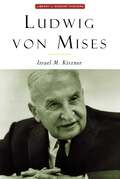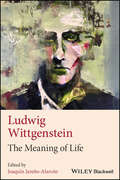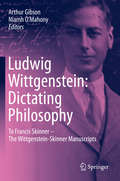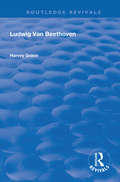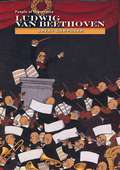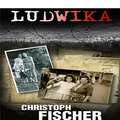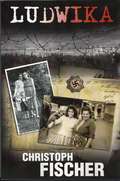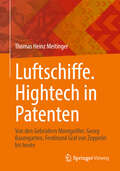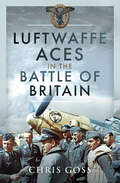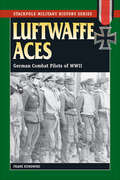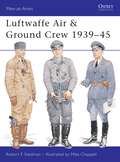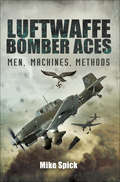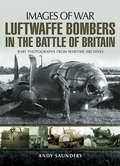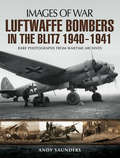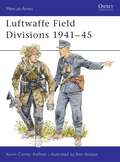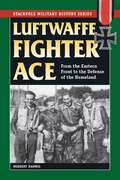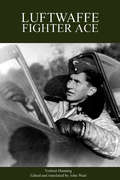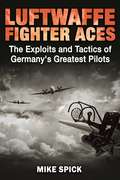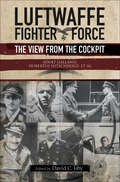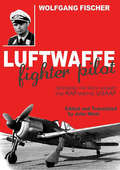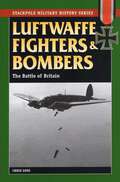- Table View
- List View
Ludwig Von Mises: The Man & His Economics (The\collected Works Of Israel M. Kirzner Ser.)
by Israel KirznerIsrael Kirzner, a former student of Ludwig von Mises, looks at the influences of the economic debates in Europe on von Mises' thought, traces his theories as they developed in his writings, and discusses both critical and supportive commentators on von Mises.
Ludwig Wittgenstein: The Meaning of Life
by Joaquín Jareño‐AlarcónOffers new insights into how Ludwig Wittgenstein understood matters concerning the meaning of life. Widely considered one of the greatest philosophers of the twentieth century, Ludwig Wittgenstein was deeply interested in the significance of religion and ethics. Although he did not systematically examine religion and the meaning of life in his major published works, Wittgenstein professed that he would at times explore fundamental issues from a religious perspective. Ludwig Wittgenstein: The Meaning of Life is the first compilation of private letters, remarks, and notes regarding Wittgenstein's thoughts and attitudes on ethics, religion, goodness, value, and moral action. With an academic approach, author Joaquín Jareño Alarcón reveals the significance of religion and ethics in Wittgenstein’s personal experience, corroborates the permanent tension between Wittgenstein and religion, highlights Wittgenstein’s preoccupation with the basic questions addressed by religious discourse, and more. Chronologically organized texts are accompanied by detailed commentary to illustrate how Wittgenstein’s interests in religion and ethics were reflected throughout his personal and intellectual evolution. Articulates Wittgenstein’s ethical point of view on religion Features a wide range of primary sources, such as personal commentaries, annotations, lecture notes, and diary entries Includes testimony of friends, students, and others with close ties to Wittgenstein Presents a balanced view of what Wittgenstein wrote and the recollections of others in his circle Discusses how the principal intention of Tractatus is to demonstrate the relevance of matters concerning religion and the meaning of lifeLudwig Wittgenstein: The Meaning of Life is essential reading for postgraduate and senior researchers, as well as advanced philosophy students and non-specialists interested in Wittgenstein’s more humanistic writings and his engagement with religion and ethics.
Ludwig Wittgenstein: To Francis Skinner – The Wittgenstein-Skinner Manuscripts
by Ludwig Wittgenstein Francis SkinnerIn this volume we witness Wittgenstein in the act of composing and experimenting with his new visions in philosophy. The book includes key explanations of the origin and background of these previously unknown manuscripts. It investigates how Wittgenstein’s philosophical thought-processes are revealed in his dictation to, as well as his editing and revision with Francis Skinner, in the latter’s role of amanuensis. The book displays a considerable wealth and variety of Wittgenstein’s fundamental experiments in philosophy across a wide array of subjects that include the mind, pure and applied mathematics, metaphysics, the identities of ordinary and creative language, as well as intractable problems in logic and life. He also periodically engages with the work of Newton, Fermat, Russell and others. The book shows Wittgenstein strongly battling against the limits of understanding and the bewitchment of institutional and linguistic customs. The reader is drawn in by Wittgenstein as he urges us to join him in his struggles to equip us with skills, so that we can embark on devising new pathways beyond confusion. This collection of manuscripts was posted off by Wittgenstein to be considered for publication during World War 2, in October 1941. None of it was published and it remained hidden for over two generations. Upon its rediscovery, Professor Gibson was invited to research, prepare and edit the Archive to appear as this book, encouraged by Trinity College Cambridge and The Mathematical Association. Niamh O’Mahony joined him in co-editing and bringing this book to publication.
Ludwig van Beethoven (Routledge Revivals)
by Harvey GraceThis volume was first published in 1927, on the centenary of Beethoven’s death, as part of the Masters of Music series. The author was an established biographer of organ composers, such as The Organ Works of Bach. Attributing Beethoven’s disagreeable demeanour to his childhood, the author embarks on a passionate defence of Beethoven’s essential nobility of character, hoping to assuage the then-prevalent anti-Beethoven chill and to encourage readers to discover Beethoven anew. The volume covers an overview of Beethoven’s life, followed by his personality and an assessment of his works in an exploration of the most important characteristics of Beethoven’s works and their influence on his successors.
Ludwig van Beethoven: Great Composer
by Anna Carew-MillerA German composer born in the 1700s, Ludwig van Beethoven has given the world some of the most well-known and long-lasting music of all time. From his Für Elise to his 9th Symphony (in which a choir sings words from the poem "Ode to Joy"), Beethoven's music is still loved, almost 200 years after his death. Amazingly, Beethoven composed music while being unable to hear almost anything from the time he was 26, a feat which makes his brilliant compositions all the more wonderful. Few musicians have had the incredible impact on music that Beethoven had. Learn the story of one of the most important musical composers of all time in Ludwig van Beethoven: Great Composer.
Ludwika
by Christoph FischerÈ la seconda guerra mondiale e Ludwika Gierz, una giovane donna polacca, è costretta a lasciare la sua famiglia e ad andare nella Germania nazista per lavorare per un ufficiale delle SS. Lì, si trova sul filo di un rasoio, costretta ad imparare a vivere come una cittadina di seconda classe in un mondo in cui una parola sbagliata potrebbe causare danni e ogni giorno potrebbe essere l'ultimo. Basato su eventi reali, questa è una storia di speranza in mezzo alla disperazione, di amore in mezzo alla perdita. . . alla fine, è la storia della sopravvivenza di una donna.
Ludwika
by Christoph Fischer Cibelle RavagliaDurante a Segunda Guerra Mundial, Ludwika Gierz, uma jovem polonesa, é forçada a deixar sua família e ir para a Alemanha nazista, onde trabalhará para um oficial da SS. Lá, Ludwika tem que aprender a conviver todos os dias com os perigos e riscos do regime nazista, sendo considerada inferior em um mundo onde uma palavra errada pode colocar sua própria vida em risco e onde todos os dias podem ser os últimos. Baseada em fatos reais, esta é um história de esperança em um mundo deseperador, uma história de amor em meio a perdas incalculáveis... enfim, é a história de uma polonesa que luta para sobreviver.
Ludwika: "Am Ende wird immer alles gut."
by Christoph FischerEs ist der Zweite Weltkrieg und Ludwika Gierz, eine junge Polin, die ihre Familie verlassen muss um in Nazideutschland für einen SS-Offizier zu arbeiten. Dort muss sie eine Gratwanderung durchmachen und erlernen, als Bürgerin zweiter Klasse in einer Welt zu leben, in der auch nur ein falsches Wort eine Katastrophe bedeuten und jeder Tag ihr letzter sein könnte. Basierend auf einer wahren Begebenheit ist dies eine Geschichte von Hoffnung, inmitten von Verzweiflung und Liebe inmitten von Verlust. . . Letztendlich ist es die Überlebensgeschichte einer Frau. Redaktionelle Rezension: "Dies ist die beste Art von Fiktion, da sie auf dem wirklichen Leben basiert. Ludwikas Geschichte zeigt das Ausmaß des menschlichen Leidens, das durch den Zweiten Weltkrieg verursacht wurde und mehrere Generationen und viele Nationen noch heute betrifft. Der Zweite Weltkrieg ließ niemanden unberührt, und Ludwikas Leben verdeutlicht diese tragische Tatsache. Sie erinnert uns aber auch daran, wie hell der menschliche Geist leuchten kann, wenn die Dunkelheit so unerbittlich fällt wie in Kriegszeiten. Dieses Buch ist eine Achterbahnfahrt voller Aktionen und Emotionen, die von Herrn Fischer gekonnt erzählt werden. Er brachte etwas Frisches und Neues zu einem Thema, über das bereits tausende von Geschichten erzählt wurden.
Ludwika: La lucha de una mujer polaca para sobrevivir en la Alemania nazi
by Christoph FischerEs la Segunda Guerra Mundial y Ludwika Gierz, una joven polaca, se ve forzada a abandonar su familia e ir a la Alemania nazi a trabajar para un oficial de las SS. Allí, su vida pende siempre de un hilo, y aprende a vivir como una ciudadana de segunda clase en un mundo en el que una palabra equivocada puede llevar al desastre, y donde cada día puede ser el último. Basada en hechos reales, es una historia de esperanza en medio de la desesperación; de amor en medio de las pérdidas...en fin, es la historia de supervivencia de una mujer. Comentarios editoriales: "Este es el mejor tipo de ficción: una historia basada en la vida real. La historia de Ludwika resalta la magnitud del sufrimiento humano causado por la Segunda Guerra Mundial, dolor que atravesó muchas generaciones y naciones. La Segunda Guerra no perdonó a nadie; todos salieron heridos, y la vida de Ludwika ilustra este hecho trágico; pero también nos recuerda cuánto puede brillar el espíritu humano cuando cae la oscuridad durante una guerra. Este libro es como un viaje en una montaña rusa, lleno de emoción y acción, narrado con mucha habilidad por el Sr. Fischer, autor que consiguió aportar algo nuevo y fresco al relatar un tema que ha sido narrado tantas veces".
Luftschiffe. Hightech in Patenten: Von den Gebrüdern Montgolfier, Georg Baumgarten, Ferdinand Graf von Zeppelin bis heute
by Thomas Heinz MeitingerAls Luftschiffe kennt man die Zeppeline. Aber die Zeppeline waren nur der Endpunkt einer technischen Entwicklung von Fahrzeugen der Lüfte, die zu Ihrer Zeit zum absoluten Hightech gehörten. In diesem Buch wird dem Leser anhand der Patentanmeldetätigkeit der Pioniere der Luftschifffahrt ein plastisches Bild vermittelt, wie sich das Ringen um die technologische Entwicklung der Luftschifffahrt in der Praxis darstellte. Das Unglück des Zeppelins „Hindenburg“ 1937 in Lakehurst, New York, kennzeichnet das jähe Ende der beispiellosen Erfolgsgeschichte der Luftschiffe.
Luftwaffe Aces in the Battle of Britain
by Chris Goss“An extraordinary analysis of the ‘scores’ chalked up by individual fighter pilots serving in the Luftwaffe during the Battle of Britain. So much detail!” —Books MonthlyThe term “fighter ace” grew in prominence with the introduction and development of aerial combat in the First World War. The actual number of aerial victories required to officially qualify as an “ace” has varied but is usually considered to be five or more.For the Luftwaffe, a number of its fighter pilots, many of whom had fought with the Legion Condor in Spain, had already gained their Experte, or ace, status in the Battle of France. However, many more would achieve that status in the hectic dogfights over southern England and the Channel during the Battle of Britain in the summer of 1940. A number would also be either killed or captured. Some of these men, individuals such as Adolf Galland, Werner Mölders, and Helmut Wick, who between them had claimed 147 aerial victories by October 31st1940, are well-known, but most are less so.In this book, the story of each of the Luftwaffe’s 204 Messerschmitt Bf 109 “aces” from the summer of 1940 is examined, with all of the individual biographies, detailing individual fates during the war, being highly illustrated throughout. Original German records from the summer of 1940, have been examined, providing a definitive list of each pilot’s individual claims. It also covers, to a lesser extent, those forgotten fifty-three Messerschmitt Bf 110 pilots who also achieved ace status by day and also by night between 10 July and 31 October 1940.“A fascinating book indeed.” —UK Historian
Luftwaffe Aces in the Battle of Britain
by Chris Goss“An extraordinary analysis of the ‘scores’ chalked up by individual fighter pilots serving in the Luftwaffe during the Battle of Britain. So much detail!” —Books MonthlyThe term “fighter ace” grew in prominence with the introduction and development of aerial combat in the First World War. The actual number of aerial victories required to officially qualify as an “ace” has varied but is usually considered to be five or more.For the Luftwaffe, a number of its fighter pilots, many of whom had fought with the Legion Condor in Spain, had already gained their Experte, or ace, status in the Battle of France. However, many more would achieve that status in the hectic dogfights over southern England and the Channel during the Battle of Britain in the summer of 1940. A number would also be either killed or captured. Some of these men, individuals such as Adolf Galland, Werner Mölders, and Helmut Wick, who between them had claimed 147 aerial victories by October 31st1940, are well-known, but most are less so.In this book, the story of each of the Luftwaffe’s 204 Messerschmitt Bf 109 “aces” from the summer of 1940 is examined, with all of the individual biographies, detailing individual fates during the war, being highly illustrated throughout. Original German records from the summer of 1940, have been examined, providing a definitive list of each pilot’s individual claims. It also covers, to a lesser extent, those forgotten fifty-three Messerschmitt Bf 110 pilots who also achieved ace status by day and also by night between 10 July and 31 October 1940.“A fascinating book indeed.” —UK Historian
Luftwaffe Aces: German Combat Pilots of WWII (Stackpole Military History Series)
by Franz KurowskiCombat biographies of seven ace pilots flying for the Nazi German air force during World War II, featuring in-the-cockpit accounts of aerial dogfights. Whether providing support for the blitzkrieg in Poland and France, bombing British cities and industrial centers, or attacking Allied fighters and bombers in the light of day and dark of night, the Luftwaffe revolutionized aerial warfare and experienced some of World War II&’s most harrowing combat. For the pilots who carried out these missions, every flight meant possible death and certain danger. Franz Kurowski puts readers in the cockpit with seven of these men—three day-fighter, on night-fighter, one close-support, and two bomber pilots—who were among the most successful ever to take to the skies.
Luftwaffe Air & Ground Crew 1939-45
by Mike Chappell Robert StedmanThe Luftwaffe, honed in the Spanish Civil War, played a vital part in Germany's 'Blitzkrieg' victories during the 1939-41 period of World War II. Badly overstretched by war on three fronts in 1942-44, it was crippled by an incompetent commander-in-chief, the losses among experienced aircrew, and shortage of fuel. In 1944-45 it faced a final battle of attrition in skies ruled by the Allies as the Eastern and Western pincers closed on the Reich; but until the very end the dwindling band of veteran pilots - among them the greatest 'aces' the world has ever known - presented a potent threat. This fact-packed review of Luftwaffe uniforms and flying kit is illustrated with rare personal photos, insignia charts, and two dozen meticulously detailed colour figures.
Luftwaffe Bomber Aces: Men, Machines, Methods
by Mike SpickThe Luftwaffe excelled at ground attack and in doing so helped revolutionised modern warfare. Whether flying in support of panzer columns during the invasion of Poland and the destruction of France, deployed against British airfields and cities, sent against Soviet tanks, or thrown into the defence of the Reich, Germany's bomber and dive-bomber pilots wrought havoc across the face of Europe during the Second World War.Mike Spike, author of a number of acclaimed books on fighter pilots, now turns his attention to outstanding ground-attack pilots. He outlines the Luftwaffe's revolutionary tactics, first tested during the Spanish Civil War, and highlights individual techniques and methods used against specific types of target.Biographical sketches of the leading bombers many of whom were awarded the Knight's Cross allow an insight into the diverse career and backgrounds of Luftwaffe personnel and outline just what it took to be a successful bomber pilot.First-hand accounts add gripping drama to the narrative, and give an unsurpassed appreciation of just what it was like to dive-bomb, come under attack by fighters or brave a barrage of anti-aircraft guns.
Luftwaffe Bombers in the Battle of Britain: Rare Photographs From Wartime Archives (Images of War)
by Andy SaundersLuftwaffe Bombers in the Battle of Britain will contains some 140-150 images of German bomber aircraft during the summer of 1940. The images will cover the entirety of the battle and will depict losses across Britain during this period. Each picture will tell its own story, and will be fully captioned with historical detail.Each section will have a short introduction and the images will include those of shot down aircraft, including relatively intact machines, badly damaged/destroyed wreckages, photographs of pilots and other related illustrations. All images are from the author's unique collection of wartime photographs of Luftwaffe losses, collected from a variety of sources across some thirty-five years of research.
Luftwaffe Bombers in the Blitz, 1940–1941: Rare Photographs From Wartime Archives (Images of War)
by Andy SaundersLuftwaffe Bombers in the Blitz will comprise of some 140-150 images of German bomber aircraft during the Blitz of 1940-1941. The images will cover the entirety of the Blitz and will also depict losses across Britain during this period. Each picture will tell its own story, and will be fully captioned with historical detail. Each section will have a short introduction and the images will include those of shot down aircraft, including relatively intact machines, badly damaged/destroyed wreckages, photographs of pilots and other related illustrations. All images are from the author's unique collection of wartime photographs of Luftwaffe losses, collected from a variety of sources across some thirty-five years of research.
Luftwaffe Field Divisions 1941-45
by Ronald Volstad Kevin RuffnerHermann Göring raised the Luftwaffe Field Divisions [LwFD] during 1942, when Nazi Germany was still making spectacular gains but was first feeling the pinch of its losses on the Eastern Front. The Reichsmarschall decided to raise his own divisions for ground service under the command of Luftwaffe officers. On 17 September 1942, Göring called for volunteers from throughout the Luftwaffe for combat duty in the East. Even before that date, however, some Luftwaffe troops were heavily engaged against the enemy in Russia in a ground role. Kevin Conley Ruffner's engaging text tells the fascinating story of the LwFD during World War II.
Luftwaffe Fighter Ace (Stackpole Military History Series)
by Norbert HanningAction-packed memoir of aerial combat. Inside the cockpits of Bf 109, Fw 190, and Me 262 fighters. Candid photos taken by the author himself.
Luftwaffe Fighter Ace: From The Eastern Front To The Defense Of The Homeland (Stackpole Military History Ser.)
by Norbert HannigA World War II memoir by the renowned German fighter pilot—from his Hitler Youth glider training to combat missions against the Soviet Air Force. Herr Norbert Hanning&’s wartime career makes for fascinating and highly informative reading on an aspect of the 1939-45 air war not often covered in the English language; primarily that of the campaign against the Soviet Union. He was one of the midwar-generation Luftwaffe fighter pilots and began operations with JG 54 on the eastern (Leningrad) front in early 1943; initially flying Messerschmitt Bf 109s before transitioning to the Focke-Wulf Fw 190. He became a Staffel CO and was credited with 42 victories, also serving with JV 44 (whose CO was Adolf Galland); he then returned to Germany towards the closing stages of the war to convert to Me 262 jet fighters. Many and varied were his experiences in action against the rejuvenated Soviet Air Force in the east, and the powerful western Allies over the homeland during the final chaotic months of hostilities, which culminated in his captivity. John Weal&’s skillful translation ensures that the fluid and descriptive style of the author is preserved. Thankfully, also, Norbert was a keen photographer who shot a profusion of images, all previously unpublished, many of which appear in this important book.
Luftwaffe Fighter Aces: The Exploits and Tactics of Germany's Greatest Pilots
by Mike SpickGet in the cockpit with some of the greatest German flying aces of all time! In this exciting book, Mike Spick shows how the Luftwaffe's leading fighter pilots were able to outscore their allied counterparts so effectively and completely during World War II. When the records of the Jagdflieger pilots became available after the war, they were initially greeted with incredulity—the highest claim was for 352 kills, and more than one hundred pilots had recorded more than one hundred victories. However, post-war research proved that these claims had in fact been made in good faith and confirmation had only been given after rigorous checking. To discover the secret of this success, aviation history expert Mike Spick examines the exploits of these aces and sets out the context in which they took place. Every major theatre is covered in detail including the conditions peculiar to each: climate, relative numerical and qualitative strengths, the presence or absence of radar and other measures, and the relative merits of the planes being flown. He focuses on the methods and tactics used by individual aces and uses first-hand sources wherever possible to put the reader right alongside the pilot in the cockpit.
Luftwaffe Fighter Force: The View from the Cockpit
by Adolf Galland Hubertus Hitschhold&“A fascinating book&” of thirty-four debriefings given by pilots and flight crew members—including the legendary German fighter ace Adolf Galland (HistoryOfWar.org). The Nazi air force pilot and crew members featured in this unusual collection divulge what was once highly-confidential information—including fighter tactics, aircraft technology and operations, and chain of command. Along with maps and diagrams, thirty rarely seen photographs are included featuring uniformed Luftwaffe officers, close-up shots of fighter planes, and the areas where the planes were authorized to carry out their missions. This unique volume was compiled by acclaimed military historian David C. Isby and is extraordinarily comprehensive. To make it, Isby poured over accounts of the war given by members of the Luftwaffe shortly after the events they describe. Much of the information in the book has been shared for the first time, and, after a limited run, is finally back in print. &“If you&’re a student of page-turning pilot memoirs from World War 2, this is a vital reference for understanding how the Luftwaffe&’s pilots functioned—and why. Regardless of whose story you&’re following, knowing how the opposing pilots came into each encounter will only enrich your appreciation of the outcome.&”—Airscape
Luftwaffe Fighter Pilot: Defending the Reich Against the RAF and the USAAF
by Wolfgang FischerA Nazi Germany fighter pilot gives readers a bird's-eye view from the cockpit of aerial combat against the Allied forces in World War II. Within weeks of war being declared, Wolfgang Fischer had volunteered to join the Luftwaffe and spent nearly five of the succeeding six years of hostilities in uniform. During this time he was given a succession of postings varying from a long-range recce unit; as a decoder in a met office in occupied France; to a bomber squadron; and as a flying instructor, before joining a squadron of the famous Richthofen Geschwader in Italy, from where he was shot down in his FW 190 by Mustangs en route to Normandy. By now a Lieutenant, he survived to fly offensive rocket attacks over Gold Beach on D-Day, only to be shot down again on D+1, and captured and sent first to a hospital in the UK, then into captivity in the USA. He was finally repatriated in April 1946. His description of all these events is entertaining and well-written, ranging from comic to tragic. It is unique in flavor, giving a valuable insight into the undeniably typical lot of those serving in the air arm of the Third Reich. Expertly translated and edited by John Weal, this is a worthy accompaniment to Norbert Hannig's Luftwaffe Fighter Ace published by Grub Street in 2004.
Luftwaffe Fighter-Bombers Over Britain (Stackpole Military History Series)
by Chris Goss Peter CornwellChronicles the air war above Britain from March 1942 to June 1943 and includes in-the-cockpit accounts from German and British pilots Assesses offensive and defensive tactics Incorporates hundreds of rarely seen photos As the Battle of Britain came to a close, the Luftwaffe began arming its single-engine fighters with bombs and using them instead of bombers for many daylight raids against shipping and coastal installations, railways, fuel depots, and other military and civilian objectives. The fighter-bombers also launched unopposed attacks against London and numerous other cities and towns across England. Known as "tip and run" attacks, these raids had a detrimental effect on British morale.
Luftwaffe Fighters and Bombers (Stackpole Military History Series)
by Chris GossThe Battle of Britain (July to October 1940), one of World War II's turning points, as seen by the German attackers who ultimately lost the battle.
